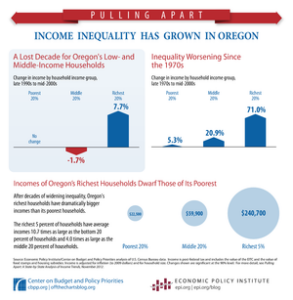The income gap that separates Oregon’s richest families from everyone else increased over the past three decades, according to a report by the Center on Budget and Policy Priorities (CBPP) and the Economic Policy Institute (EPI). Their report found that the gap between the richest families and those in the middle of the income scale grew faster in Oregon than in all but six other states.

“Oregon’s economic story of the past three decades is one of surging income inequality,” said Jason Gettel, policy analyst with the Oregon Center for Public Policy. “The destabilizing and debilitating effect that income inequality has on our economy should be a chief concern among Oregon policymakers.”
After adjusting for inflation, from the late 1970s to the mid 2000s Oregon’s richest one-fifth of households increased their average annual income 71 percent, from $99,769 to $170,632, according to the two Washington, D.C. think tanks. By contrast, over the same period the middle fifth of Oregon households saw their average yearly income increase 20.9 percent, from $49,949 to $60,412.
The fact that the rich’s income increased more than three times faster than middle-income people placed Oregon seventh among all states in terms of how fast the richest group pulled away from the middle group.
Oregon’s richest households also left behind Oregon’s low-income households. From the late 1970s to the mid 2000s, the average annual income of Oregon’s poorest fifth of households increased from $20,888 to $22,003 — a 5.3 percent gain compared to a 71 percent increase for the rich. The growth in the income gap between the wealthiest fifth and the poorest fifth in Oregon ranked 19th nationally, according to the report.
OCPP calculated that had the incomes of all Oregonians kept pace with those of the rich, low-income families on average would have earned an additional $13,722 or 62 percent more in annual income than they did in the mid 2000s. Middle-income families would have earned $25,015 more in annual income, a 41 percent gain.
The report compared after-tax income and takes into account certain benefits received by low-income families, namely the Earned Income Tax Credit and the cash value of food stamps and housing subsidies.
Notably, the report did not take into account income from capital gains — income derived from the profitable sale of stock, bonds, real estate and other assets. Because it excludes capital gains income, the report understates income inequality, its authors explained.
Income from capital gains overwhelmingly goes to those at the top of the income scale. According to separate analysis by OCPP, in 2010 the top 1 percent of Oregon families collected about 70 percent of all capital gains income in the state.
Oregon was not unique in the rise of income inequality. The report said that over the past three decades the gap between the wealthy and the rest widened in all states and the District of Columbia.
While reducing income inequality requires concerted federal action in a number of areas, including tax policy and job creation, there are steps that Oregon can take to make sure that the problem doesn’t worsen, according to Gettel.
“The first rule that Oregon lawmakers should follow is, ‘do no harm,’” he said. “That means, above all, no new tax cuts for the rich because they would only exacerbate the problem.”
In recent months, some lawmakers and pundits have once again called for a cut to Oregon’s income tax on capital gains, but that would take the state in the wrong direction.
“A cut in the income tax on capital gains is a tax cut not just for the rich, but for the very rich,” said Gettel. “It would increase income inequality without benefiting the overall economy.”
Another way to “do no harm,” according to Gettel, is to maintain Oregon’s Earned Income Tax Credit (EITC). The tax credit helps over 250,000 low-income working families in Oregon — mostly families with children. It is scheduled to expire at the end of 2013 unless the legislature renews it.
“The federal EITC is one of the most effective anti-poverty programs in existence, and it also mitigates income inequality,” Gettel said. “Oregon lawmakers should make extending the state EITC a top priority to avoid making Oregon’s income inequality problem worse.”





